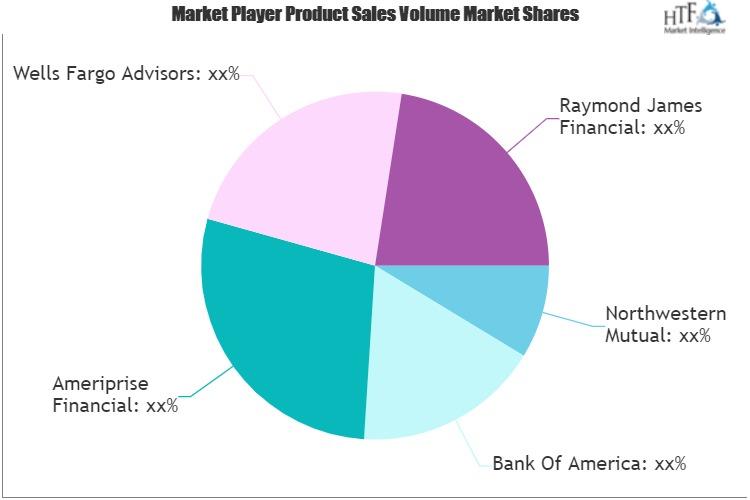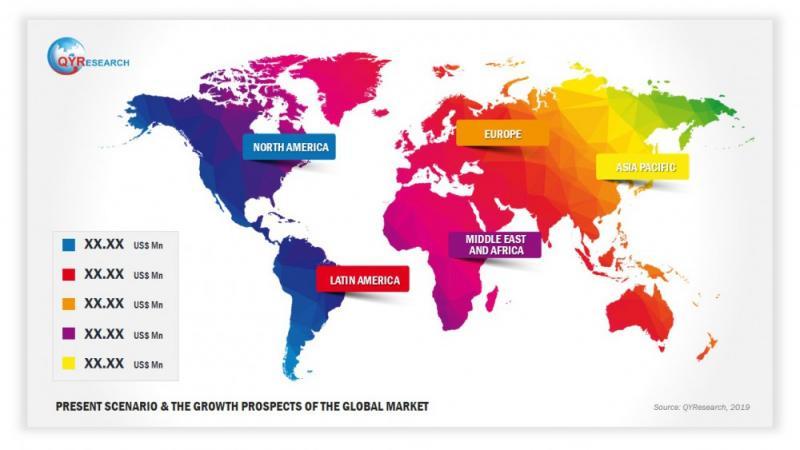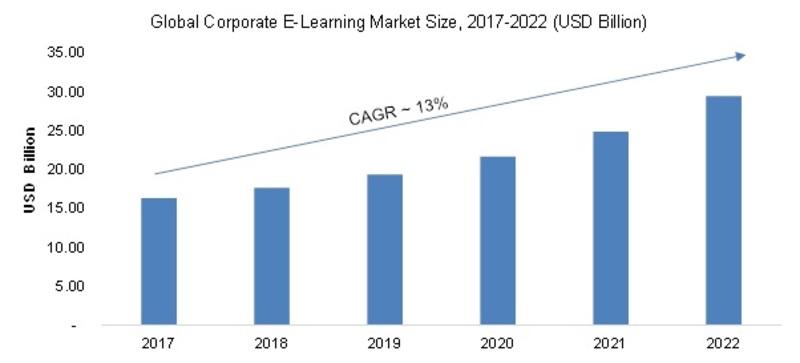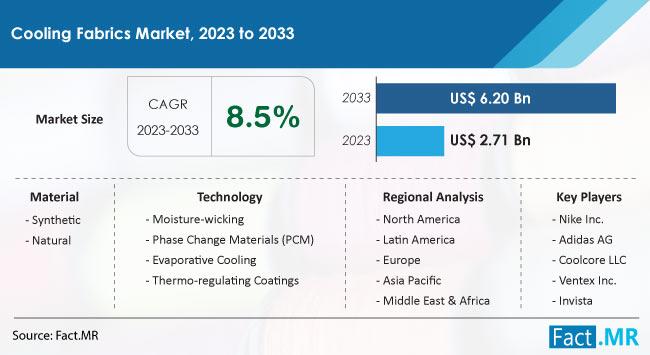Press release
Cooling Fabrics Market Size to Exceed USD 6.2 Billion by 2033, with a Robust CAGR of 8.5% |Fact.MR
According to Fact.MR, a supplier of market research and competitive information, the global Cooling Fabrics Market is expected to grow at an 8.5% CAGR and reach a valuation of US$ 6.2 billion by the end of 2033.
Cooling textiles can be made from synthetic materials. They are a creation that provides a sense, moderate warmth, and a soft texture similar to human skin. These textiles provide additional convenience to customers by boosting perspiration evaporation and avoiding the fabric from adhering to the body. Cooling fabrics' main advantages are their capacity to circulate moisture and regulate evaporation. It is vital to note that these fabrics are not the same as the textiles used to control temperature.
For More Insights into the Market, Request a Sample of this Report:
https://www.factmr.com/connectus/sample?flag=S&rep_id=8917
The expanding global demand for cooling fabrics is being driven by an increased knowledge of the benefits of comfortable clothes. Notably, the sports industries in the United States, China, Brazil, Russia, and Malaysia are rapidly adopting cooling materials. This trend derives from players' rising knowledge of the value of wearing comfortable clothing, which improves their overall comfort levels throughout athletic events. Furthermore, a sizable proportion of sports professionals prefer premium fabrics for their clothing.
Throughout the forecast period, demand for cooling fabrics is expected to rise sharply in emerging economies. This expansion is likely to be driven by causes such as rising economic affluence, changing lifestyles, and a booming sports culture.
Key Takeaways from Market Study
By 2023, the global market for cooling fabrics is expected to be worth $2.71 billion.
Global demand for cooling fabrics is expected to grow at an 8.5% CAGR until 2033.
By the end of 2033, the global market is expected to be worth $6.2 billion.
The Chinese market is expected to grow at a CAGR of 4.4% from 2023 to 2033.
Under material, the use of synthetic cooling fabrics is expected to increase at a CAGR of 4.6% until 2033.
Demand for natural cooling fabrics is expected to grow at a 6% CAGR from 2023 to 2033.
North America dominates the cooling fabrics market in 2023, accounting for 38% of the total.
Sales of moisture-wicking cooling fabrics are projected to increase at a CAGR of 8.6% through 2033.
"The key driver of market revenue growth is the increased usage of cooling materials in protective wear and athletic gear. Over the projected period, an increase in research & development activities in cooling textiles is expected to fuel worldwide sales growth," says a Fact.MR analyst.
Get Customization on this Report for Specific Research Solutions:
https://www.factmr.com/connectus/sample?flag=RC&rep_id=8917
Market Competition
The cooling fabric market is highly fragmented, with a small number of large and medium-sized players accounting for the majority of revenue. Major firms are pursuing mergers and acquisitions, strategic partnerships, and the introduction of sophisticated products in order to maintain their position and stay ahead of their competitors.
Brrr Pro is a new cooling fabric introduced in December 2020. Textiles with micro-cooling minerals, performance drying, and hyper-wicking strengthen the 'triple chill' effect, providing a refreshing and comfortable experience.
Donghua University in China developed a new type of cooling fabric in July 2020 by combining multiple polymers. These materials effectively dissipate heat, wick away perspiration, and deflect outside water.
𝐑𝐞𝐚𝐝 𝐌𝐨𝐫𝐞: https://www.factmr.com/report/cooling-fabrics-market
More Valuable Insights on Offer
Fact.MR, in its new offering, presents an unbiased analysis of the global cooling fabrics market, presenting historical demand data for 2018 to 2022 and forecast statistics for 2023 to 2033.
The study divulges essential insights into the market based on material (synthetic, natural), textile type (woven, non-woven, knitted), technology (moisture-wicking, phase change materials [PCM], evaporative cooling, thermo-regulating coatings), and application (sports apparel, protective wearing, lifestyle, medical textiles, home textiles), across five major regions of the world (North America, Europe, Asia Pacific, Latin America, and the Middle East & Africa).
𝐂𝐨𝐧𝐭𝐚𝐜𝐭:
US Sales Office
11140 Rockville Pike
Suite 400
Rockville, MD 20852
United States
Tel: +1 (628) 251-1583, +353-1-4434-232
Email: sales@factmr.com
𝐀𝐛𝐨𝐮𝐭 𝐅𝐚𝐜𝐭.𝐌𝐑
We are a trusted research partner of 80% of fortune 1000 companies across the globe. We are consistently growing in the field of market research with more than 1000 reports published every year. The dedicated team of 400-plus analysts and consultants is committed to achieving the utmost level of our client's satisfaction.
Cooling textiles can be made from synthetic materials. They are a creation that provides a sense, moderate warmth, and a soft texture similar to human skin. These textiles provide additional convenience to customers by boosting perspiration evaporation and avoiding the fabric from adhering to the body. Cooling fabrics' main advantages are their capacity to circulate moisture and regulate evaporation. It is vital to note that these fabrics are not the same as the textiles used to control temperature.
For More Insights into the Market, Request a Sample of this Report:
https://www.factmr.com/connectus/sample?flag=S&rep_id=8917
The expanding global demand for cooling fabrics is being driven by an increased knowledge of the benefits of comfortable clothes. Notably, the sports industries in the United States, China, Brazil, Russia, and Malaysia are rapidly adopting cooling materials. This trend derives from players' rising knowledge of the value of wearing comfortable clothing, which improves their overall comfort levels throughout athletic events. Furthermore, a sizable proportion of sports professionals prefer premium fabrics for their clothing.
Throughout the forecast period, demand for cooling fabrics is expected to rise sharply in emerging economies. This expansion is likely to be driven by causes such as rising economic affluence, changing lifestyles, and a booming sports culture.
Key Takeaways from Market Study
By 2023, the global market for cooling fabrics is expected to be worth $2.71 billion.
Global demand for cooling fabrics is expected to grow at an 8.5% CAGR until 2033.
By the end of 2033, the global market is expected to be worth $6.2 billion.
The Chinese market is expected to grow at a CAGR of 4.4% from 2023 to 2033.
Under material, the use of synthetic cooling fabrics is expected to increase at a CAGR of 4.6% until 2033.
Demand for natural cooling fabrics is expected to grow at a 6% CAGR from 2023 to 2033.
North America dominates the cooling fabrics market in 2023, accounting for 38% of the total.
Sales of moisture-wicking cooling fabrics are projected to increase at a CAGR of 8.6% through 2033.
"The key driver of market revenue growth is the increased usage of cooling materials in protective wear and athletic gear. Over the projected period, an increase in research & development activities in cooling textiles is expected to fuel worldwide sales growth," says a Fact.MR analyst.
Get Customization on this Report for Specific Research Solutions:
https://www.factmr.com/connectus/sample?flag=RC&rep_id=8917
Market Competition
The cooling fabric market is highly fragmented, with a small number of large and medium-sized players accounting for the majority of revenue. Major firms are pursuing mergers and acquisitions, strategic partnerships, and the introduction of sophisticated products in order to maintain their position and stay ahead of their competitors.
Brrr Pro is a new cooling fabric introduced in December 2020. Textiles with micro-cooling minerals, performance drying, and hyper-wicking strengthen the 'triple chill' effect, providing a refreshing and comfortable experience.
Donghua University in China developed a new type of cooling fabric in July 2020 by combining multiple polymers. These materials effectively dissipate heat, wick away perspiration, and deflect outside water.
𝐑𝐞𝐚𝐝 𝐌𝐨𝐫𝐞: https://www.factmr.com/report/cooling-fabrics-market
More Valuable Insights on Offer
Fact.MR, in its new offering, presents an unbiased analysis of the global cooling fabrics market, presenting historical demand data for 2018 to 2022 and forecast statistics for 2023 to 2033.
The study divulges essential insights into the market based on material (synthetic, natural), textile type (woven, non-woven, knitted), technology (moisture-wicking, phase change materials [PCM], evaporative cooling, thermo-regulating coatings), and application (sports apparel, protective wearing, lifestyle, medical textiles, home textiles), across five major regions of the world (North America, Europe, Asia Pacific, Latin America, and the Middle East & Africa).
𝐂𝐨𝐧𝐭𝐚𝐜𝐭:
US Sales Office
11140 Rockville Pike
Suite 400
Rockville, MD 20852
United States
Tel: +1 (628) 251-1583, +353-1-4434-232
Email: sales@factmr.com
𝐀𝐛𝐨𝐮𝐭 𝐅𝐚𝐜𝐭.𝐌𝐑
We are a trusted research partner of 80% of fortune 1000 companies across the globe. We are consistently growing in the field of market research with more than 1000 reports published every year. The dedicated team of 400-plus analysts and consultants is committed to achieving the utmost level of our client's satisfaction.
Permanent link to this press release:
Copy
Please set a link in the press area of your homepage
to this press release on woodPRI. woodPRI disclaims liability for any content contained in
this release.
Recommend

/newsMicroencapsulation Market Deep Analysis on Key Players - Dow Corning, Encapsys, Syngenta Crop Protection, Evonik Industries, 3M and Bayer
Market Study Report Adds Global Microencapsulation Market Size, Status and Forecast 2024 added to its database. The report provides key statistics on the current state of the industry and other analytical data to understand the market.
Extensive research is required for choosing the appropriate cor...

/newsGermany Airbag Market Size 2023: Global Share, Industry And Report Analysis By 2030 | Hyundai Mobis Co., Ltd. Key Safety Systems, Inc. Robert Bosch GmbH
Germany airbag market is expected to grow at a CAGR of around 6% during the forecast period. Germany Airbag Market research report refers to gathering and analyzing significant market data serve as best medium for various industry players to launch novel product or service. It is vital for key firms...

/newsSecurities Brokerages And Stock Exchanges Market Outlook 2021: Big Things are Happening
A new intelligence report released by HTF MI with title "Global Securities Brokerages And Stock Exchanges Market Survey & Outlook" is designed covering micro level of analysis by Insurers and key business segments, offerings and sales channels. The Global Securities Brokerages And Stock Exchange...

/newsRenewable Chemicals Market Emerging Trends and Competitive Landscape Forecast to 2028
The renewable chemicals market was valued at US$ 80,566.30 million in 2021 and is projected to reach US$ 1,76,750.76 million by 2028 it is expected to grow at a CAGR of 11.9% from 2021 to 2028. The research report focuses on the current market trends, opportunities, future potential of the market, a...

/newsHow Coronavirus is Impacting Cold Brew Coffee, Global Market Volume Analysis, Size, Share and Key Trends 2020-2026
"Market Latest Research Report 2020:
Los Angles United States, February 2020: The Cold Brew Coffee market has been garnering remarkable momentum in the recent years. The steadily escalating demand due to improving purchasing power is projected to bode well for the global market. QY Research's lates...

/newsCorporate E-Learning Market - Global Industry Size, Share, Key Players Analysis that are Infor, SkillSoft Corporation, Adrenna, CERTPOINT Systems and others with Regional Forecast to 2022
Overview:
E-Learning is used to enhance the learning procedures for newer job requirements and to make employees sound about the internal and external changes in the market and respective organizations. This method has created considerable differences in the ways of training and developing employee...
